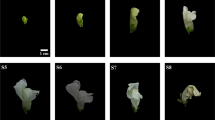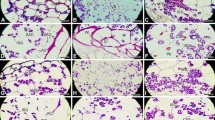Abstract
Features of programmed cell death (PCD) and dynamic changes of starch accumulation in developing pericarp cells of wheat (Triticum aestivum L.) were observed and analyzed by periodic acid–Schiff/toluidine blue O double staining, fluorescence staining, terminal deoxynucleotidyl transferase-mediated fluorescein deoxyuridine triphosphate nick-end labeling (TUNEL) and transmission electron microscopy. The results showed that cellular organelles were orderly disintegrated. TUNEL-positive nuclei were detected at 0 day after flowering (DAF), whereas nuclei showed significant features of degradation at 2 DAF, such as chromatin condensation, nuclei condensation, and nuclei deformation. Then, heterochromatin gradually disappeared and the cellular nucleus was completely degraded. The mitochondria degradation and vacuolation also were detected at 15 DAF. These results indicated that the development of pericarp cells was a typical process of PCD. However, the PCD in pericarp cells had their own characteristics: PCD started early and lasted for a considerable time. In the delayed process of PCD, starch granules were synthesized, deposited, and degraded temporarily in amyloplasts or chloroplasts. The delay of PCD in pericarp cells may be due to sufficient photosynthetic assimilates and energy supply. Besides, normal mitochondria were required for pericarp cells to survive. Pericarp cells contained only compound starch granules. Starch was massively synthesized from 0 to 11 DAF, but it was rapidly degraded after 11 DAF. Therefore, apart from protection, pericarp cells played essential roles in starch synthesis, storage, and degradation, as well as nutrient transportation.







Similar content being viewed by others
Abbreviations
- DAF:
-
day after flowering
- DBF:
-
days before flowering
- HR:
-
hypersensitivity reaction
- NSGA:
-
numbers of starch granules in one amyloplast
- NAC:
-
numbers of amyloplasts in one cell
- PCD:
-
programmed cell death
- TUNEL:
-
terminal deoxynucleotidyl transferase-mediated fluorescein deoxyuridine triphosphate nick-end labeling
References
Ameisen JC (2002) On the origin, evolution, and nature of programmed cell death: a timeline of four billion years. J Cell Death Differ 9:367–393. doi:10.1038/sj.cdd.4400950
Chevalier P, Lingle SE (1983) Sugar metabolism in developing kernels of wheat and barley. J Crop Sci 23:272–277
Earp CF, McDonough CM, Rooney LW (2004) Microscopy of pericarp development in the caryopsis of Sorghum bicolor (L.) Moench. J Cereal Sci 39:21–27. doi:10.1016/S0733-5210(03)00060-2
Gaffal KP, Friedrichs GJ, El-Gammal S (2007) Ultrastructural evidence for a dual function of the phloem and programmed cell death in the floral nectary of Digitalis purpurea. J Ann Bot (Lond) 99:593–607. doi:10.1093/aob/mcm002
Groover A, DeWitt N, Heidel A, Jones A (1997) Programmed cell death of plant tracheary elements differentiating in vitro. J Protoplasma 196:197–211. doi:10.1007/BF01279568
Gu Y-J, Wang Z, Chen J, Zhao G-Y (2002) The structure and function of pericarp in rice. J Acta Agronomica Sin 28(4):439–444
Hu S-Y (1964) Study on the dynamic state of starch accumulation in the development of wheat caryopsis. J Acta Bot Sin 12(2):139–148
Ishida-Yamamoto A, Yamauchi T, Tanaka H, Nakane H, Takahashi H, Iizuka H (1999) Electron microscopic in situ DNA nick end-labeling in combination with immunoelectron microscopy. J Histochem Cytochem 47:711–717
Jones AM (2001) Programmed cell death in development and defense. Plant Physiol 125:94–97. doi:10.1104/pp. 125.1.94
Lan S-Y, Zhong F-X, Yang Z-M, Jin D-M, Xu Z-X (2004) The starchy endosperm denucleation by a process of programmed cell death during rice grain development. J Acta Biologiae Exp Sin 37(1):34–44
Mea MD, Serafini-Fracassini D, Duca SD (2007) Programmed cell death: similarities and differences in animals and plants. A flower paradigm. J Amino Acids 33:395–404. doi:10.1007/s00726-007-0530-3
Nakamura T, Vrinten P, Hayakawa K, Ikeda J (1998) Characterization of a granule-bound starch synthase isoform found in the pericarp of wheat. J Plant Physiol 118:451–459. doi:10.1104/pp. 118.2.451
Otsuki Y, Li ZL, Shibata MA (2003) Apoptotic detection methods: from morphology to gene. J Prog Histochem Cyto 38:275–339. doi:10.1016/S0079-6336(03)80002-5
Pennell RI, Chris L (1997) Programmed cell death in plants. J Plant Cell 9:1157–1168. doi:10.1105/tpc.9.7.1157
Rolletschek H, Weschke W, Weber H, Wobus U, Borisjuk L (2004) Energy state and its control on seed development: starch accumulation is associated with high ATP and steep oxygen gradients within barley granules. J Exp Bot 55(401):1351–1359. doi:10.1093/jxb/erh130
Van Doorn WG (2005) Plant programmed cell death and the point of no return. J Trends Plant Sci 10:478–483. doi:10.1016/j.tplants.2005.08.003
Wang Y-Q, Cui K-M (1998) Programmed cell death during the vessel element differentiation of the secondary xylem in Eucommia ulmoides shoots. J Acta Bot Sin 40:1102–1107
Wang L-K, Zhou Z-Q, Song X-F, Li J-W, Deng X-Y, Mei F-Z (2008) Evidence of ceased programmed cell death in metaphloem sieve elements in the development caryopsis of Triticum aestivum L. Protoplasma 234:87–96. doi:10.1007/s00709-008-0023-6
Zhou Z-Q (2000) Study on the physiological characteristics of resource, sink and flow and the microstructural or ultrastructural changes of kernels during the process of kernel development in wheat (Triticum aestivum L.) cultivars. Ph.D. dissertation of Huazhong Agricultural University
Zhou Z-Q, Zhu X-T, Wang W-J, Lan S-Y (2001) Observation on the amyloplasts in endosperm of wheat varieties with different kernel types by scanning electron microscope. J Chin Electron Microsc Soc 20(3):178–184
Acknowledgements
Our deepest gratitude goes to first and foremost the National Nature Science Foundation of China (30571101) for their financial support. We also owe our sincere thanks to Mrs. Cui Wang for her revising on the earlier draft.
Conflict of interest
We have a financial relationship with the organization that sponsored the research. We declare that we have no conflict of interest.
Author information
Authors and Affiliations
Corresponding author
Additional information
Zhuqing Zhou and Likai Wang contributed equally to this work.
Rights and permissions
About this article
Cite this article
Zhou, Z., Wang, L., Li, J. et al. Study on programmed cell death and dynamic changes of starch accumulation in pericarp cells of Triticum aestivum L.*. Protoplasma 236, 49–58 (2009). https://doi.org/10.1007/s00709-009-0046-7
Received:
Accepted:
Published:
Issue Date:
DOI: https://doi.org/10.1007/s00709-009-0046-7




